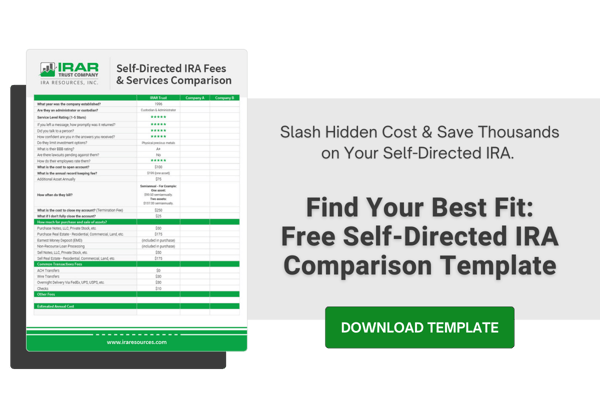Mortgage Notes Secrets: Invest In Real Estate With A Self-Directed IRA

You want to invest in real estate, but don’t want the hassle of finding a tenant, collecting rent, and managing repairs? You can invest in real estate notes instead! With many of the same benefits (but without all the headaches), promissory notes secured by real estate are becoming more and more common, especially with self-directed IRA investors.
Here’s what you need to know:
What is a Mortgage Note/Real Estate Note?
Formally called a promissory note secured by real property, these are promissory notes backed by either a Deed of Trust or a Mortgage Deed (the name changes depending on where in the country you’re located). A promissory note is a promise to pay or repay a certain amount of money, either at a specific time or in regular installments. A Deed of Trust, also known as a Mortgage Deed, is a document that places a lien against the property once it has been recorded at the local county office. So instead of buying real estate through a direct purchase, investors are loaning money from their IRA to another investor— essentially acting as the bank— but in this case, since it is secured by real estate, if the borrower defaults on the loan the IRA can foreclose on the property.
Relevant: Buying Real Estate With A Self-Directed IRA
How to Invest in Real Estate Notes: Step-By-Step
Step One:
First on your list should be finding a qualified borrower and a property they’re interested in buying. This can be done yourself or through a reputable private loan company, but IRA Resources can’t do this for you. You can also find investors through a broker or at real estate investment clubs, as these investors are always looking to make deals. Make sure you are not lending to a disqualified person— this is not allowed by the IRS and can lead to your account being fully distributed.
Step Two:
Once you’ve located a borrower, the process is simple. If you haven’t already, you’ll need to open a self-directed IRA with IRA Resources and fund your account with a transfer or rollover. When the funds have arrived, it’s time to start investing!
Step Three:
It’s time to finalize the promissory note. IRA Resources does not provide any of this paperwork, aside from our own Buy Direction Letter— you will need to provide this yourself. Clients typically do this through a broker, a closing company, or (if it’s a simple promissory note) some do it themselves. There are resources on the internet to help you determine how to handle this process.
Once you’ve compiled your documents, it’s time to submit your paperwork so your purchase can be funded. Some of the items listed below may not apply to your transaction— those have been noted “as applicable”. Please reach out to an IRA Resources representative if you are unsure whether a specific document is required for your transaction.
You’ll need to send the following to initiate the transaction:
- A signed and completed Buy Direction Letter: Real Estate Note Form
- It is essential that the information on the Buy Direction Letter (BDL) matches all your other documents. Be sure to verify the borrower’s name, the property address (if applicable), the loan amount, maturity date, interest rate, and payment amount— ensure that all this information is accurate and matches on all documentation before submitting, as this is the leading cause of delays in transactions.
- A copy of the Promissory Note.
- Make sure the lender’s name and address is listed correctly, with the vesting in the name of the IRA (IRA Resources, Inc FBO Client Name Account #123456). The lender’s address should be listed as IRA Resources’ Oakland Processing Center (unless you are using a loan servicing company, in which case you’ll use their address) to ensure the payments are being correctly deposited in your account.
- A copy of the Deed of Trust/Mortgage Deed
- Title Commitment or Preliminary Title Report from the title company (as applicable)
- These documents are used to make sure the borrower is properly insured (with their name matching the name on the insurance document) and that the Loan Policy of Title Insurance is for at least the amount of the loan, if not greater.
- With the Preliminary Title Report, we’re verifying the borrower’s name matches the name on the report.
- Escrow or Title Company’s Wiring Instructions (as applicable)
- Closing Instructions (as applicable)
If Investing in an Existing Note
For an existing note, the required documents are the same— you will need to submit any of the applicable documents listed above. However, your existing promissory note will come prefilled with the previous lender’s information and you’ll need to update these documents to reflect your IRA as the new owner. You do that by adding an amendment to each document, showing the updated lender (your IRA).
Specifically, you’ll need to submit an amendment for the following documents:
- Your Promissory Note
- Since you are purchasing an existing note, the lender’s name will not be listed on the note itself. You’ll need an Assignment of Note/Note Endorsement showing the newly reflected lender is your IRA (vested as listed above).
- Your Deed of Trust/Mortgage Deed
- This document also won’t have the lender’s name listed. You’ll need to provide an Assignment of Deed of Trust/Assignment of Mortgage, showing the loan being transferred from the existing lender to IRA Resources.
- Your Title Commitment or Preliminary Title Report from the title company (as applicable)
- The insurance will be in the name of the previous owner. This is okay for the term of the insurance but must be renewed in the name of the IRA.
- There should be a note under “exceptions” stating a new deed will be recorded in the name of the new borrower.
No matter if your note is new or existing, it’s incredibly important that you verify the information is correct and matches on all paperwork— the information written on the Buy Direction Letter must match everything on all accompanying documentation. Any discrepancies will require a follow up from IRA Resources, which may delay your transaction. We’ll specifically be checking the borrower’s name, the property address (if applicable), the loan amount, maturity date, interest rate, and payment amount on all documents to confirm before processing your transaction. Also, you must make sure the vesting on every document is correctly listed as “IRA Resources, Inc FBO Client Name Account #12345”, as an incorrect vesting can cause problems down the line.
We need these documents to verify your note is properly vested in the name of the IRA and secured by real estate, as intended, before we’ll send out the requested funding.
Once this process is finalized and your money has been received by the borrowers— that’s it, you’re done! You’ve invested in a real estate promissory note.
Relevant: Partnering Your Self-Directed IRA: Using Someone Else’s Money to Invest in Real Estate
Conclusion
Remember: when investing in real estate notes with your self-directed IRA:
- The note needs to be vested in the name of the IRA, not IRA Resources’ or your personal name.
- Make sure the borrower has the correct address for IRA Resources— this is where they will be sending payments, so you’ll want to verify they have the right information.
- Do not lend to a disqualified person. This can result in your IRA being forcibly distributed, with the full amount immediately taxable. A disqualified person is you, your spouse, your children, and any other lineal ascendants or descendants.
- IRA Resources does not service the loan for you. You can hire a loan servicing company if you want, but you are not required to do so.
- We don’t keep track of payments— you are responsible for verifying borrowers are paying as agreed according to the original note agreement, and for calculating the payoff amount. You can access information on deposited payments via your online IRAR account.
Real estate notes are the low-hassle solution many self-directed IRA investors turn to, especially if you’re interested in real estate but don’t want to deal with all the extra work. No matter your strategy— with self-direction, you’ve got some options.
To learn more about investing in real estate notes with your self-directed IRA, schedule a free consultation with one of our Certified IRA Services Professionals (CISPs). Happy investing!








Comments (4)